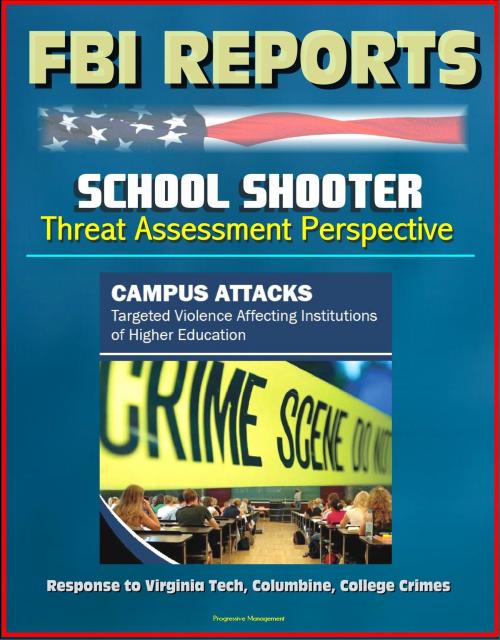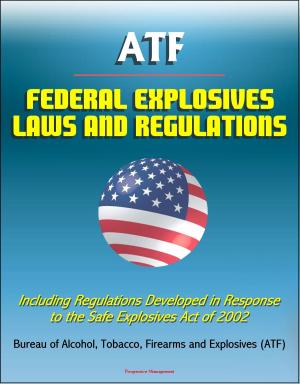FBI Reports: School Shooter Threat Assessment Perspective, Campus Attacks, Targeted Violence Affecting Institutions of Higher Education - Response to Virginia Tech, Columbine
Nonfiction, Social & Cultural Studies, Political Science, Politics, Law Enforcement, Reference & Language, Education & Teaching, Administration| Author: | Progressive Management | ISBN: | 9781301982417 |
| Publisher: | Progressive Management | Publication: | April 27, 2013 |
| Imprint: | Smashwords Edition | Language: | English |
| Author: | Progressive Management |
| ISBN: | 9781301982417 |
| Publisher: | Progressive Management |
| Publication: | April 27, 2013 |
| Imprint: | Smashwords Edition |
| Language: | English |
Two major FBI reports about educational crime threats are reproduced in this important ebook: The School Shooter: A Threat Assessment Perspective - Critical Incident Response Group (CIRG), and Campus Attacks: Targeted Violence Affecting Institutions of Higher Education.
School Shooter: Why would a student bring a weapon to school and without any explicable reason open fire on fellow students and teachers? Are school shooters angry? Are they crazy? Is their motive revenge? Hatred for the victims? A hunger for attention? The origins of human violence are complex. Thinkers, historians, and scientists have explored the issue for centuries, but answers remain elusive. The roots of a violent act are multiple, intricate, and intertwined. The mix of factors varies according to the individual and the circumstances. Understanding violence after it has occurred is difficult enough. Trying to assess a threat and keep it from being carried out is even more of a challenge. This monograph presents a systematic procedure for threat assessment and intervention. The model is designed to be used by educators, mental health professionals and law enforcement agencies. Obviously, the same events that led the National Center for the Analysis of Violent Crime (NCAVC) to this subject have also led school administrators and law enforcement officials across the country to consider and develop their own policies and procedures for dealing with threats or acts of violence in schools. * NCAVC's Study and the Leesburg Symposium * The School Shooter Phenomenon and Threat Assessment * Misinformation About School Shootings * Chapter II * Assessing Threats * What is a Threat * Motivation Signposts * Types of Threats * Factors in Threat Assessment * Levels of Risk * Chapter III * Four-Pronged Assessment Approach * The Four-Pronged Assessment Model * Personality of the Student * Family Dynamics * School Dynamics * Social Dynamics * Chapter IV * Findings * Prong One: Personality Traits and Behavior * Prong Two: Family Dynamics * Prong Three: School Dynamics * Prong Four: Social Dynamics * Chapter V * The Intervention Process * Threat Management In Schools * The Role of Law Enforcement * Examples of Threats * Low-Level Threat * Medium-Level Threat * High-Level Threat * Chapter VI * Recommendations and Conclusions
Campus Attacks: On April 16, 2007, Seung Hui Cho, 23, a student at Virginia Polytechnic Institute and State University ("Virginia Tech") in Blacksburg, Virginia, carried out what would become one of the deadliest school shootings in the world. Around 7:15 a.m., Cho fatally shot a female student in her dormitory room in West Ambler Johnston Residential Hall and then shot the building's residential advisor. Approximately two-and-a-half hours later, Cho entered Norris Hall, a lecture building, and shot numerous students and faculty before killing himself. In total, Cho killed 32 (27 students and five faculty members) and wounded 17. Some of the wounded individuals were struck by gunfire while others were injured trying to jump from the building. This killing spree stunned the nation and questions echoed throughout the country from parents, administrators, and government officials alike. In response, Virginia Governor Timothy Kaine established the Virginia Tech Review Panel (VTRP) on June 18, 2007, to gain a better understanding of the incident and its underlying causes so that steps could be taken to minimize the chances of a similar tragedy happening again.
Two major FBI reports about educational crime threats are reproduced in this important ebook: The School Shooter: A Threat Assessment Perspective - Critical Incident Response Group (CIRG), and Campus Attacks: Targeted Violence Affecting Institutions of Higher Education.
School Shooter: Why would a student bring a weapon to school and without any explicable reason open fire on fellow students and teachers? Are school shooters angry? Are they crazy? Is their motive revenge? Hatred for the victims? A hunger for attention? The origins of human violence are complex. Thinkers, historians, and scientists have explored the issue for centuries, but answers remain elusive. The roots of a violent act are multiple, intricate, and intertwined. The mix of factors varies according to the individual and the circumstances. Understanding violence after it has occurred is difficult enough. Trying to assess a threat and keep it from being carried out is even more of a challenge. This monograph presents a systematic procedure for threat assessment and intervention. The model is designed to be used by educators, mental health professionals and law enforcement agencies. Obviously, the same events that led the National Center for the Analysis of Violent Crime (NCAVC) to this subject have also led school administrators and law enforcement officials across the country to consider and develop their own policies and procedures for dealing with threats or acts of violence in schools. * NCAVC's Study and the Leesburg Symposium * The School Shooter Phenomenon and Threat Assessment * Misinformation About School Shootings * Chapter II * Assessing Threats * What is a Threat * Motivation Signposts * Types of Threats * Factors in Threat Assessment * Levels of Risk * Chapter III * Four-Pronged Assessment Approach * The Four-Pronged Assessment Model * Personality of the Student * Family Dynamics * School Dynamics * Social Dynamics * Chapter IV * Findings * Prong One: Personality Traits and Behavior * Prong Two: Family Dynamics * Prong Three: School Dynamics * Prong Four: Social Dynamics * Chapter V * The Intervention Process * Threat Management In Schools * The Role of Law Enforcement * Examples of Threats * Low-Level Threat * Medium-Level Threat * High-Level Threat * Chapter VI * Recommendations and Conclusions
Campus Attacks: On April 16, 2007, Seung Hui Cho, 23, a student at Virginia Polytechnic Institute and State University ("Virginia Tech") in Blacksburg, Virginia, carried out what would become one of the deadliest school shootings in the world. Around 7:15 a.m., Cho fatally shot a female student in her dormitory room in West Ambler Johnston Residential Hall and then shot the building's residential advisor. Approximately two-and-a-half hours later, Cho entered Norris Hall, a lecture building, and shot numerous students and faculty before killing himself. In total, Cho killed 32 (27 students and five faculty members) and wounded 17. Some of the wounded individuals were struck by gunfire while others were injured trying to jump from the building. This killing spree stunned the nation and questions echoed throughout the country from parents, administrators, and government officials alike. In response, Virginia Governor Timothy Kaine established the Virginia Tech Review Panel (VTRP) on June 18, 2007, to gain a better understanding of the incident and its underlying causes so that steps could be taken to minimize the chances of a similar tragedy happening again.















